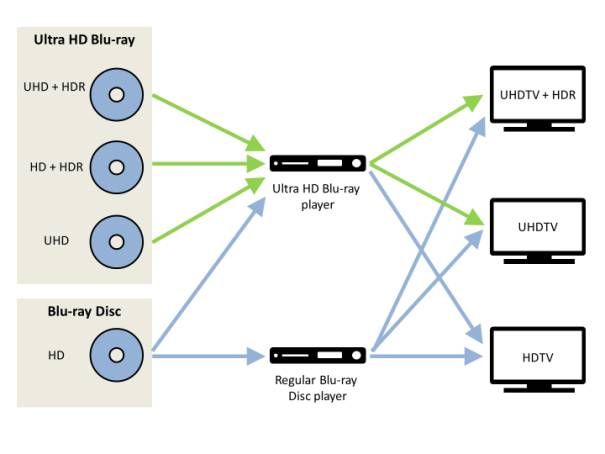Ultra HD Blu-ray's versatile compatibility explained
This month, the first Ultra HD Blu-ray Disc player and the first discs have reached the market. New discs and new players raise all sorts of mutual compatibility questions. The Blu-ray Disc association (BDA) has attempted to answer those questions in a single chart. Because of the many different disc flavors, player, TV sets and interfaces it has become a rather complicated chart.

One could divide this chart into separate charts showing just a single scenario each but the resulting multitude of charts would make it equally difficult to navigate.
Below is my attempt at simplifying the chart while retaining the same level of detail by adding a simple table.


In essence, what the chart conveys is that everything works, except the new discs on legacy players.
Such compatibility would have been possible by retaining the same dual-layer 50GB physical BD-ROM format as regular Blu-ray Discs have used since 2006. This is much in the same way Hybrid SACD discs can be played on legacy CD players. There would however be hardly enough space for a high quality Ultra HD movie, let alone for adding the HD version on the same disc. Instead, studios have resorted to the more pragmatic solution of bundling a separate disc with the HD version of a movie.
Let's look at the elements one by one.
Discs
In addition to the existing (1080p HD) Blu-ray Disc there are three new disc 'flavors' defined in the new Ultra HD Blu-ray format:
- Ultra HD (3840×2160) resolution with High Dynamic Range (HDR)
- Ultra HD resolution with Standard Dynamic Range (SDR)
- HD (1920×1080) resolution with High Dynamic Range
Whether that last type, HD+HDR, will be used on disc remains to be seen. A few dozen titles have been announced by Twentieth Century Fox, Sony Pictures and Warner Bros Home Entertainment including many that were not shot, edited and mastered in 4K but at lower resolutions such as 2K, yet all of the discs are '4K' UHD. It's quite likely the studios will upscale all movies to 4K resolution in order to meet consumer expectations. Arguably, manual control and monitoring by a studio, not necessarily real-time but on a frame-by-frame basis if needed, promises greater results than real-time upscaling by a retail TV or Ultra HD Blu-ray player.
All the new discs can be played on the new players, as can the conventional Blu-ray discs (as well as DVD-Video and Audio CD in all likelihood) but support for these and other 'legacy' formats is entirely open to choice by the hardware manufacturer).
None of the new disc types can be played on legacy Blu-ray Disc players. They would not be able to handle the changed physical parameters like the increased data density and the higher number of layers.
Players
There are two types of players:
- Ultra HD Blu-ray players
- Blu-ray Disc players
As discussed in above, the new players can be expected to play everything the 'old' ones could, as well as all the new disc types.
TV sets
The chart distinguishes three types of TV sets:
- Ultra HD TV with HDR
- Ultra HD TV without HDR, i.e. with SDR
- HDTV
Note that in principle it's possible to produce an HDTV set that supports HDR but in practice such sets have not been announced and seem unlikely.
The UHD TV with HDR, of course, can play everything. For Ultra HD content it requires at least HDMI 2.0 with HDCD 2.2 content protection, while for HDR it further requires HDMI 2.0a (probably this was still tentatively referred to as HDMI 2.1 when this chart was made).
A UHD TV without HDR can of course play UHD discs without HDR, but what happens when you try playing a UHD discs with HDR on such a TV set? The interesting and practical thing is that this will also work: The player will render an SDR 'downmix' . What this downmix looks like is determined by the studio during the mastering of the title. The TV set needs to support HDMI 2.0 and HDCP 2.2. Early UHD TVs from 2014 and before that are equipped only with HDM 1.4 will get 30fps UHD at best. That wouldn't be a serious drawback since most movies are 24fps only. However, another constraint applies: Movie discs will typically be copy-protected and require a TV to support HDCP 2.2. The earlier generations of UHD TVs (with HDMI 1.4 and HDCP 1.4) lack this and will not be able to play such discs in UHD with HDR but can play them in HD with SDR, because another interesting aspect is that Ultra HD Blu-ray players must be able to downscale Ultra HD to HD (a process that of course is much more trivial than upscaling).
The practical effect of this is that someone who has yet to purchase a UHD TV may already buy an Ultra HD Blu-ray player, start building a collection of Ultra HD Blu-ray Discs and can play them already on his or her legacy HDTV set, albeit of course only in HD with SDR, for the time being.
Conclusion
Although the underlying technology may be complicated my conclusion is quite simple: Except for new discs on old players, every scenario will work... provided the right connections are in place. Where the connections are not as required, graceful degradation takes place as much as possible.
Yoeri Geutskens has worked in consumer electronics for more than 15 years. He writes about high-resolution audio and video. You can find his blog about Ultra HD Blu-ray at @UltraHDBluray.